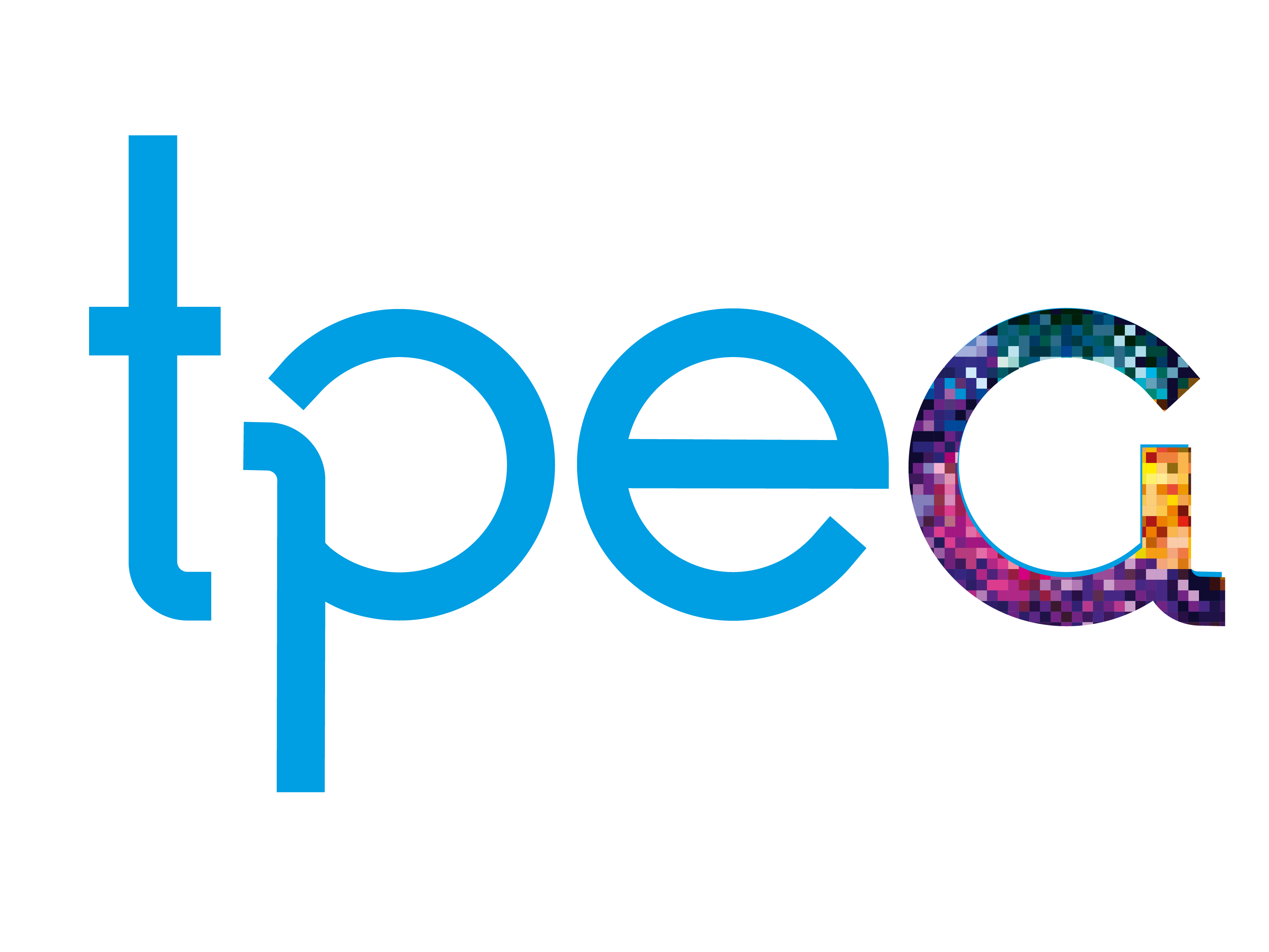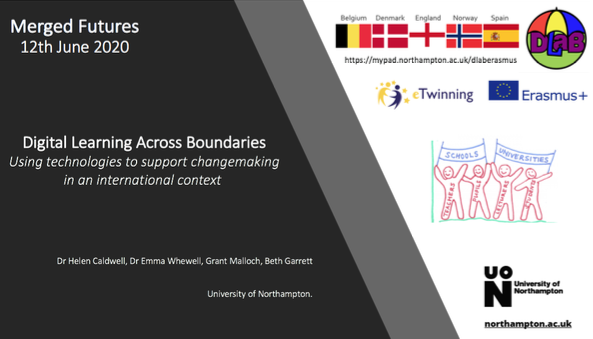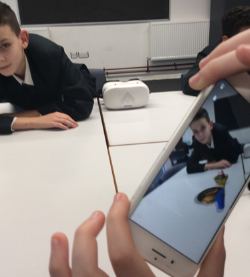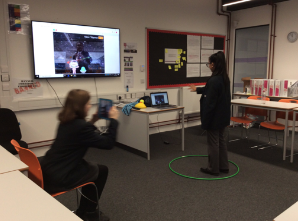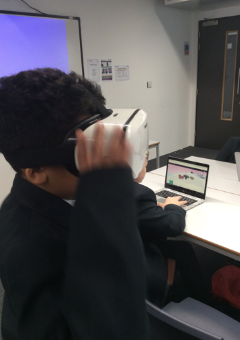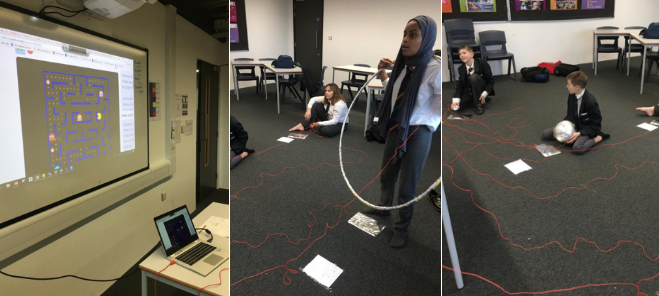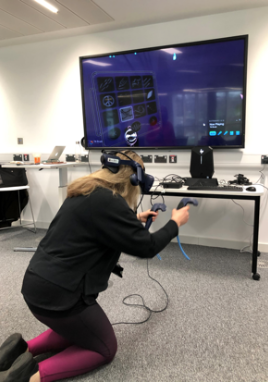DLAB presentation at Merged Futures 2020
A team of four lecturers and students from the University of Northampton presented at the online Merged Futures conference 2020 on 12th June https://www.digitalnorthampton.com/mergedfutures organised by Digital Northampton https://www.digitalnorthampton.com/.
The team shared just one out of four strands of the Digital Learning Across Boundaries (DLAB) Erasmus+ funded project explored in 2019/2020. The overall theme this year was ‘crossing physical boundaries’ and this strand was based on a subgroup of Danish and English teams of university lecturers, teachers, student teachers and Year 7 pupils working together on the theme of exergaming. You can follow the development of this strand of the project in these slides and in the commentary below.
Combining Digital Making and Changemaking to promote physical activity
The English and Danish subgroup within the larger project team explored the use of immersive technologies such as AR and VR in combination with other technologies to address the problem of teenage inactivity. Inspired by their experiences of exergaming at the Sports Innovation Campus in Bruges that combined digital and physical activity, participants in Denmark and England used technology for:
- developing intercultural awareness by swapping digital artefacts about themselves and their environments
- designing exergames for each other to test and suggest improvements
- creating a prototype solution to combat the problem of inactivity in a 360° environment
The aims of this sub strand were:
- to create playful learning environments that encourage creativity, collaboration, innovation and entrepreneurship.
- to enable participants to develop the confidence, values, beliefs and skills needed to become digitally literate changemakers.
Background to the theme
This strand of the DLAB project is based on the idea that exergaming is particularly appealing to young people and there have been many success stories including the Wii Fit, the Nintendo Switch and XBox Kinect. Of particular note was the Pokemon Go phenomenon in 2016 which brought augmented reality (AR) to the masses almost overnight.
We were keen to explore the potential for virtual reality (VR) and AR in combination with other technologies to enhance the exergaming experience and provide a motivating medium for children to invent innovative solutions to problems they identified and cared about.
There is a distinction between VR that completely immerses users in a digital world and AR, which superimposes digital information or virtual objects into the real world. AR allows for a reality where virtual objects appear to coexist in the same space with the real world.
Recent advancements in these technologies have meant that they are now more accessible, more mainstream and particularly well suited to children. Numerous studies have reported an increase in intensity of physical activity as well as higher ratings of enjoyment and interest, suggesting that the immersive qualities of AR are more likely to distract participants from the physical exertion (Lin and Chang, 2015; Faric et al., 2019).
Working closely with pupils, student teachers, teachers and lecturers in the Danish team during designated ‘international days’ as well as pre and post days, the group explored the use of technologies with pupils at Northampton International Academy. There was an emphasis on using VR and AR alongside a range of other technology tools in a creative way by making digital artefacts to swap and share.
Using technology to get to know each other
As part of our international days, we wanted children to have the opportunity to connect with the children in Denmark and learn about each other’s cultures and lifestyles. Prior to the first international day, we introduced the project to Year 7 pupils at Northampton International Academy. The children in both countries used iPads and 360° cameras to take videos and images of their school which we edited using Google Tour Creator to provide virtual tours of their schools. These were shared on the first international day and the children found it really interesting to make comparisons.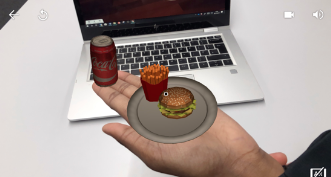
On the first international day, as one of the activities, we used CoSpaces to create virtual environments and objects which could then be viewed using AR or VR. Pupils in the two countries used CoSpaces to swap virtual meals with foods that they would typically eat. They were able to view these using AR through their phones and also using VR headsets. Our aim was for the children to use CoSpaces on a future international day to create virtual exergaming environments.
Children also created some AR animated GIFS as festive greetings which were shared with Denmark.
Below is a summary of the technologies we used for getting to know each other during and between the international days:
- Keynote AR animated GIFs + EyeJack app: swapping festive greetings
- Google Earth VR: exploring each other’s countries
- sharing 360° images and videos of our school environments
- Roundme app: making 360° virtual tours
- use of videoconferencing and twitter to support collaboration during the international days
- CoSpaces for sharing virtual meals that represent our countries in VR and AR
- Tweetfall to display a live Twitter feed and videoconferencing tools
Pupils demonstrated that the technology helped to build intercultural understanding:
‘Talking to other countries was a good idea because it lets them see what we do in our country and what they do in their country…Seeing how they are doing their tasks will help us to understand how we can do ours better’
‘Using simple things like your phone or VR headset allows you to experience things in the world and understand more of the world’
Using technology to design exergames
An aim of the first international day was to introduce the theme of technology supporting physical activity. We wanted pupils to choose from a range of technologies to invent exergames to swap with their Danish partners. A starting point was to give the pupils a carousel of choices so that they could explore the potential for designing their own games. A rolling deck of tweets was used throughout the day to give pupils a sense of interdependence as they worked towards a shared goal, and they chatted to each other using videoconferencing tools.
This exploring technology phase included:
- making step counters out of Microbits (tiny programmable computers ) using the Micro:bit app on iPads.
- building exercise circuits using Makey Makeys combined with electric fence wire and conductible materials such as tin foil. The Makey Makey is an electronic tool that connects conductible materials to the computer so objects can act as computer keyboard keys.
- programming motion sensing games in the coding environment of Scratch using a webcam to detect movements and control objects on the screen.
- using the PlankPad app with balance boards.
- designing gaming environments in CoSpaces.

On the second international day we added VR and AR to some of these technologies to design our own immersive exergames. We also made video instructions for the games to swap with Denmark. This resulted in a range of invented exergames to swap, test and evaluate between the countries, such as:
- virtual reality table tennis
- balance boards in combination with VR
- basketball coaching videos in VRusing 360 cameras
- a physical movement challenge using the Cardboard Camera app
- a Microbits and Scratch remix of a balance board challenge
- Makey Makey games
- a soccer video sensing game in Scratch
The images below show an example of a Pac-Man makey makey game. The arrow keys, space and return on the keyboard are controlled using physical movements with foil covered apparatus, such as hoops and balls. These are connected with electric fence wire to make a circuit that controls the Pac-Man characters on the screen. Pupils tested this invention with a number of online games, collaborating as teams and competing as individuals.
Pupils spoke positively about using technology in this way:
‘Things you use in regular day with technology can be used in different ways to help enhance your life physically’
‘There’s so much more to technology than just tapping games. It can motivate you to help with your health.’
Using technologies for prototyping innovative solutions
The plan for the third international day was for Northampton International Academy pupils to visit the university and work with a set of HTC Vives and CoSpaces. Unfortunately, the visit was cancelled due to Covid-19 and so just the students and lecturers trialed the combination of technologies for day 3, to explore the final part of the crossing physical boundaries challenge:
Design a prototype digital artefact that draws from artificial realities to stimulate physical activity and addresses the issue of young people’s addiction to online games.
We wanted to use virtual reality apps to design 3D objects within 360° environments to develop our prototype solution of an imagined exergaming environment with an embedded exergaming challenge.
We went some way towards achieving this by trialing a combination of five VR tools and apps using the HTC Vive. First we opened the app Tiltbrush to paint in 3D space using the handsets with a range of brushes and effects. We found that this could be combined with imported sculpted 3D objects from Google Blocks, objects and scenes from the Google Poly library of 3D resources for use in VR and AR environments, and our own objects and scenes from CoSpaces. The result was an imagined world containing an exergaming challenge that we could interact with in VR using the handsets. Our plan had been to create our own libraries and scenes to swap with our partners in Denmark. By trialing this combination of apps, we could see the potential for prototyping solutions to a range of changemaker challenges.
Overall, we think the exergaming strand of the DLAB project this year has demonstrated that the use of VR and AR tools in combination with other technologies can help pupils become creative digital makers and changemakers. Through collaboration with their international partners they demonstrated that they could have an impact on an identified challenge and develop empathy and understanding. As the pupils said:
‘I think we have done changemaking because it shows that we can also help make a difference by joining together physicality and technology’
‘We haven’t changed the world forever, but we have made a difference and we have shown people that we can help with the future’
University of Northampton research team
Dr Helen Caldwell: Senior Lecturer
Dr Emma Whewell: Senior Lecturer
Grant Malloch: Postgraduate student
Beth Garrett: Undergraduate student
References
Faric, N., Yorke, E., Varnes, L., Newby, K., Potts, H.W., Smith, L., Hon, A., Steptoe, A. and Fisher, A., 2019. Younger Adolescents’ Perceptions of Physical Activity, Exergaming, and Virtual Reality: Qualitative Intervention Development Study. JMIR Serious Games, 7(2), p.e11960.
Lin, C.Y. and Chang, Y.M., 2015. Interactive augmented reality using Scratch 2.0 to improve physical activities for children with developmental disabilities. Research in developmental disabilities, 37, pp.1-8.
Online courses
The University of Northampton has three flexible online courses for educators starting in September 2020:
Postgraduate Certificate in Digital Leadership
https://www.northampton.ac.uk/courses/postgraduate-certificate-in-digital-leadership
Online MA Education
https://www.northampton.ac.uk/courses/education-ma
PGCE Top-Up
https://www.northampton.ac.uk/courses/pgce-topup
Contact: helen.caldwell@northampton.ac.uk
